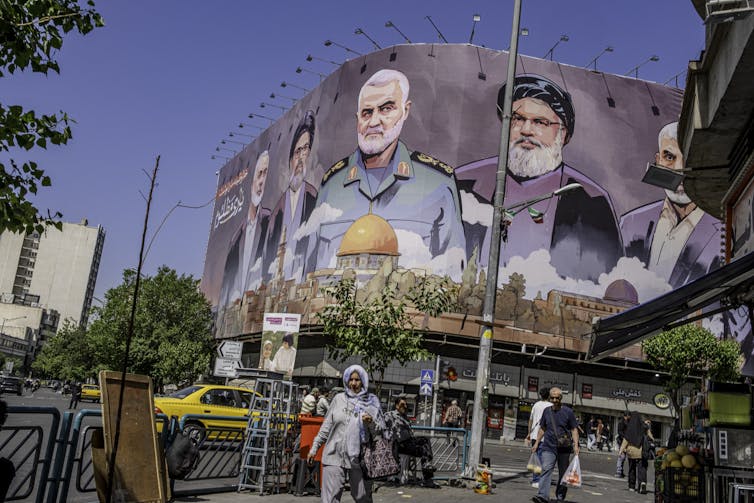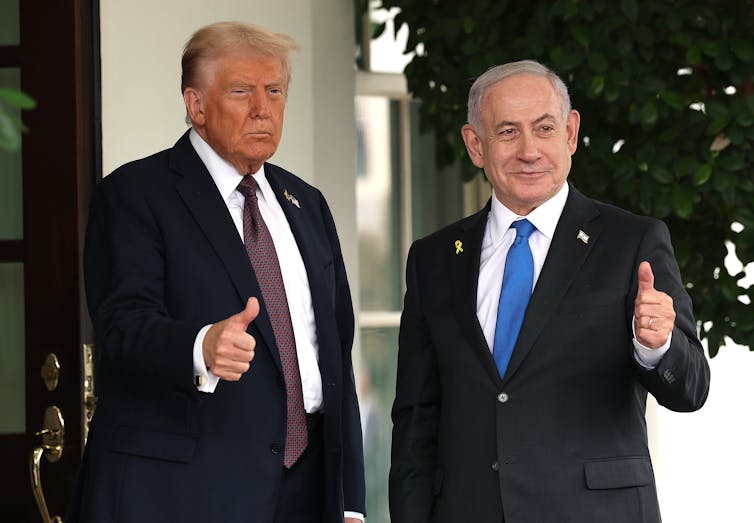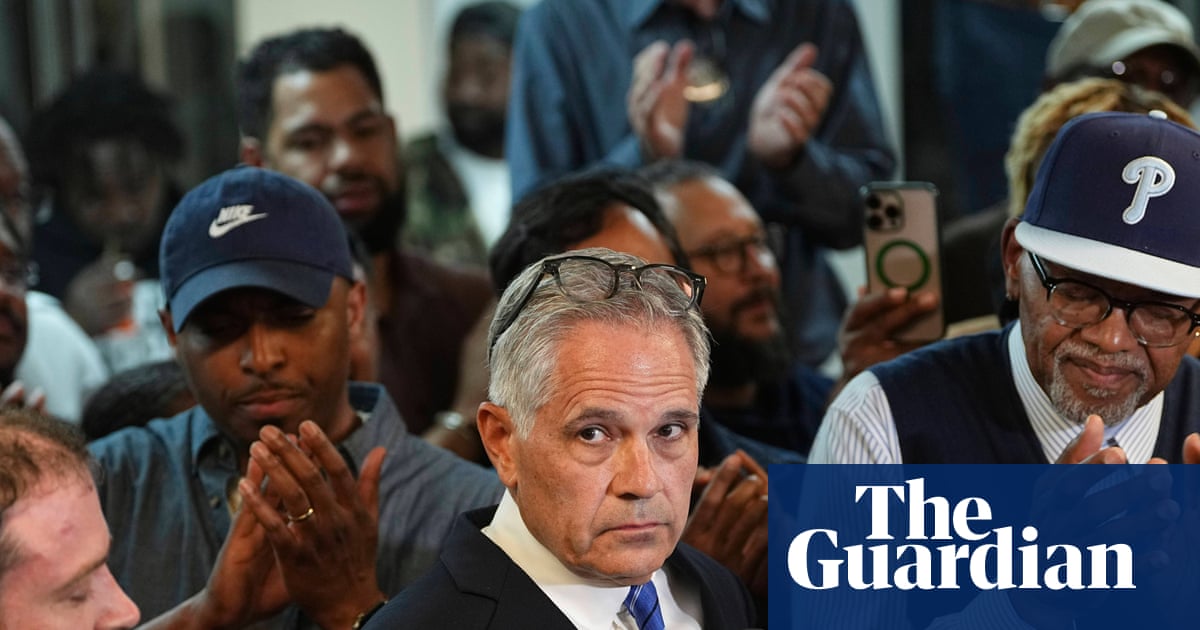Weakened militarily and facing declining Palestinian support, particularly among Gazans, Hamas was already a shadow of the militant group it once was. And then came President Donald Trump’s peace plan.
On Oct. 3, 2025, Hamas said that it accepted some aspects of the 20-point proposal, including handing over administration of the Gaza Strip to a body of independent Palestinian technocrats and releasing all remaining Israeli hostages.
Those hostage are the last of the 252 taken during the Oct. 7, 2023, attack – an event that two years on looks to represent a high point, so to speak, of Hamas’ power. As an expert on Palestinian political attitudes, I believe the group now has few options to survive.
Like former resistance groups in past peace processes, it could renounce arms and transform itself into a purely political party. But to do so, it needs to overcome a series of hurdles: confronting other parts of Trump’s plan, its unpopularity at home and its rigid ideology being the three most prominent.
Campaign of assassination
It is worth taking stock of just how degraded Hamas has become as the result of two years of onslaught by Israel’s vastly superior military.
According to many intelligence reports, Hamas has lost most of its senior command in the Al-Qassam Brigades, its military wing. Izz al-Din al-Haddad, its current commander, survives, having presumably taken over from Mohammed Sinwar – the brother of Yahya Sinwar, mastermind of Oct. 7 attack – who was killed in May 2025. But he presides over a dwindling army.
President Trump may not have been exaggerating when he indicated on Truth Social on Oct. 3 that Hamas had lost 25,000 fighters. Estimates regarding the group’s losses vary, but it could represent more than half of the fighting force it had at the beginning of the war.
Hamas has succeeded in recruiting new fighters during that time. But many of these new recruits lack the competence and the experience of the dead ones. And the only motivations the new recruits have are hate and anger toward Israel.
Hamas’ political leadership has also been decimated. Chief political leaders, including Ismail Haniyeh, Saleh al-Arouri and Yahya Sinwar, have all been killed.

And it could have been worse. Had the Israeli attack on Hamas’ political leadership in Doha, Qatar, succeeded in September 2025, it could have been a devastating loss for the movement. But the operation missed its primary targets there.
Falling support in Gaza
Palestinian public pressure on Hamas has risen as the miseries of war have mounted.
According to local heath officials, more than 67,000 have been killed, and more than 169,000 have been injured. Most of the Gaza Strip has been reduced to rubble, and more than 90% of the population has been displaced multiple times – with most Gazans now living in tents. International organizations have reported famine and starvation in some parts of the Gaza Strip.
Hamas has lost its power and influence over many areas now under Israeli control. Israeli military and intelligence have encouraged some members of the local Palestinian clans and militia to offer services in militia-controlled areas.
In such areas, Hamas fighters have often clashed with other Palestinian groups, resulting in many deaths and growing resentment toward Hamas.
Hamas’ execution and torture of Palestinians suspected of collaboration with Israel has only worsened the situation, leading to chaos and lawlessness in many parts of Gaza.
It is little wonder, then, that half of Gazans in the latest poll of attitudes – taken in May 2025 – say they supported anti-Hamas demonstrations. Indeed support for the group in both Gaza and the West Bank have continued to decline as the war has progressed.
The push for peace
The ongoing war and the inhumane daily conditions that local Palestinians in Gaza are dealing with have led to exhaustion and fatigue among the public.
On social media, many Palestinians are asking Hamas publicly to endorse the Trump plan and put an end to their misery.
In deciding whether to accept all of the plan’s 20-points, Hamas will, from its perspective, have to weigh whether agreeing to a very bad outcome is better than the alternative. Trump has warned that a failure to get on board will cause Hamas to face “all hell.”
Hamas has already agreed to release all of the remaining Israeli hostages and to relinquish power in Gaza to a technocratic Palestinian committee. If endorsed in full, this would put an end to the war and see the gradual Israeli withdrawal from Gaza, and no expulsion of the Palestinians out of Gaza.
Egypt, Qatar and Turkey have been facilitating Hamas’ response to the plan. And there is huge regional and international pressure to get the deal over the line.
However it would force Hamas to disarm itself and allow the entry of an international and regional force into Gaza to oversee the destruction of military infrastructure, including tunnels, weapon manufacturing and the remaining rockets – points of the latest plan that Hamas appears more unwilling to accept.
What happens to the remaining Hamas fighters is a sticking point that might lead to the collapse of the whole plan.
And any rejection of the plan that can be blamed on Hamas will no doubt be welcomed by members of the Israeli extreme right. Hardline factions of Israeli Prime Minister Benjamin Netanyahu’s coalition have an alternative plan: to fully occupy Gaza, expel the Palestinians and reestablish Israeli settlements in Gaza.

Where next for Hamas?
Perhaps the most viable option for Hamas is to transform itself into a political party. But to do so, the group will need to reform not only its structures but also its ideology.
Political momentum is swinging back to a two-state solution. France and Saudi Arabia recently spearheaded a fresh push to that end at the United Nations, and a host of Western nations recognized Palestinian statehood for the first time. Hamas may feel the pressure to finally accept a two-state solution, something it has long resisted. For its part, Trump’s plan only makes vague assertions noting the Palestinian “aspiration” for a state.
If transforming into a purely political party is to be the fate of Hamas, it will need to play its cards shrewdly and swiftly. The Palestine Liberation Organization went through this process after their departure from Beirut in 1982, eventually putting politics and diplomacy over armed resistance. And Qatar, Turkey and Egypt can help Hamas moderate its stances, too.
The rigid ideology of Hamas remains a hurdle. Since it was formed in 1987, Hamas has tethered itself to a hardline Islamist ideology that does not allow fundamental compromises on issues such as recognition of Israel and the development of Palestine as a secular state.
But there is the recent example of Syria, where following the ouster of long-term dictator Bashar al-Assad, the main Islamist fighting group pivoted to politics, and was lauded in the international community for doing so.
Whether Hamas can succeed in such a transformation – should it attempt to – remains to be seen. And there is one final snag: Even if Hamas does accept the latest peace proposal, other Palestinian militant groups in Gaza might not – and could attempt to sabotage the whole process.

 German (DE)
German (DE)  English (US)
English (US)  Spanish (ES)
Spanish (ES)  French (FR)
French (FR)  Hindi (IN)
Hindi (IN)  Italian (IT)
Italian (IT)  Russian (RU)
Russian (RU)  4 weeks ago
4 weeks ago
























Comments